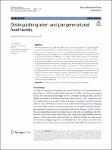Item Infomation
Full metadata record
| DC Field | Value | Language |
|---|---|---|
| dc.contributor.author | Stefan, Mann | - |
| dc.contributor.author | Daria, Loginova | - |
| dc.date.accessioned | 2023-04-12T01:46:47Z | - |
| dc.date.available | 2023-04-12T01:46:47Z | - |
| dc.date.issued | 2023 | - |
| dc.identifier.uri | https://link.springer.com/article/10.1186/s40100-023-00252-z | - |
| dc.identifier.uri | https://dlib.phenikaa-uni.edu.vn/handle/PNK/7793 | - |
| dc.description | CC BY | vi |
| dc.description.abstract | While food trends are usually described over an entire population, this paper suggests distinguishing between inter- and pangenerational food trends. To classify the food trends for the total population as inter- or pangenerational, we used disaggregated household-based consumption data on 60 food categories over the period from 1990 to 2020 in Switzerland. We followed six different cohorts with a range of 10 birth years each and estimated robust trends for each generation and each product. Our results show that especially for meat, different generations follow different trends and form ‘intergenerational’ trends for the total population, whereas beans and peas would be an example of products with an increasing consumption for every single generation and a ‘pangenerational’ trend. | vi |
| dc.language.iso | en | vi |
| dc.publisher | Springer | vi |
| dc.subject | Distinguishing inter- | vi |
| dc.title | Distinguishing inter- and pangenerational food trends | vi |
| dc.type | Book | vi |
| Appears in Collections | ||
| OER - Kinh tế và Quản lý | ||
Files in This Item:

